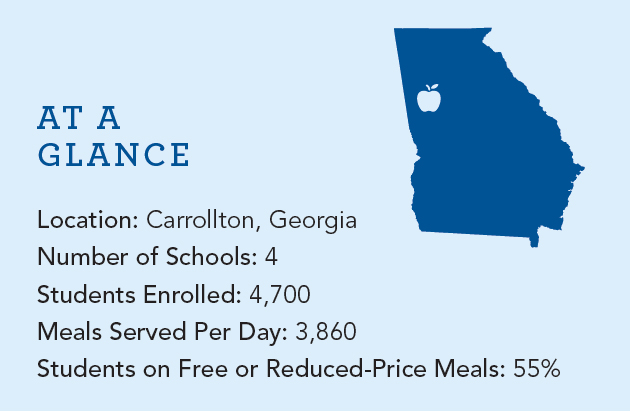Carrollton City Schools: A School Food Success Story
The Challenge
While the district had been working to instill healthy eating habits among students and staff for a decade, school administrators formalized the effort in 2010 by setting higher nutrition standards. The challenges they faced included limited vendor options for whole-grain products; inadequate storage for additional fresh fruits and vegetables; and overall increases in meal preparation time, as they used fewer processed foods.
Some of the Solutions
Cafeteria staff estimated that increasing the variety of fruit and vegetables added 30 to 60 minutes of labor per day. Food service staff now keeps labor costs manageable by adjusting menus to balance healthy options with efficient preparation. When menus include a fresh-cut item (e.g., oranges, apples), staff pairs it with a whole fruit or another side requiring minimum labor (e.g., frozen broccoli). To maintain sufficient storage for the increased volume, produce deliveries are scheduled for twice a week. Staff also closely monitors food preparation and student consumption to avoid over-production and minimize waste, which helps offset the higher costs of whole-grain products.
Measures of Success
The schools now serve a different fruit and vegetable each day of the week; three to five are fresh, with many being seasonal and locally grown. School nutrition administrators estimate consumption of fruit has increased by 40 percent and vegetable consumption by 30 percent. The numbers also indicate that the changes have not impacted the school's revenue. School lunch participation held steady during the 2010-11 school year, while breakfast participation rose by 5 percent.
Snacks and Beverages
To supplement the changes taking place in the cafeteria, school administrators eliminated sugar-sweetened beverages from school vending machines. They now serve only water and 100 percent fruit juices. Alternative fundraisers, such as t-shirt sales during homecoming and sports team play-offs, have offset the lost vending revenue.
The #1 Lesson Learned
Carrollton City administrators and food service staff agree that buy-in from all staff members, including teachers, has been fundamental to the district's success. Establishing a team approach among school administrators, teachers, and cafeteria staff was a critical first step.
Read more "School Food Success Stories" from school districts across the nation.








